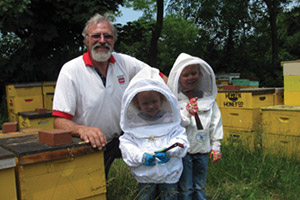Grandpa’s Helpers
Attached is a photo of my two grandkids, Josh and Rachel. They are getting old enough to have fun with grandpa in the beehives.
Andy Hemken
Big Bend, WI
andy@hemkenhoney.com
Silly Science Not So: Senator Flake’s Wastebook and Science-Funding Advice
In May 2016, U.S. Senator Jeff Flake (R-AZ) issued a “Wastebook” that highlighted twenty federally funded scientific studies that he believed were a waste of our tax dollars. I had the dubious honor of being called-out as the #1 perpetrator. My research, Honey Bee Sting Pain (https://peerj.com/articles/338/) by Body Location, aimed to answer the question: where is the most painful place to be stung by a honey bee? As a graduate student working with honey bees, I noticed that the painfulness of stings varied with body location. Being a curious biologist, I decided to systematically study the painfulness of honey bee stings. Interestingly, stings are more painful near the airways (nose and mouth) than in places you might assume (genitals). It makes sense that the human body would respond more strongly to a sting near the airways, because such a sting is potentially life threatening.
The Wastebook claimed that I received part of a 1 million dollar grant to Cornell University from the National Science Foundation to conduct this research. However, I did not receive even $1 from the National Science Foundation for my sting pain research. I did it all on my own time, at no cost to the US taxpayer. As for materials, what did I need? Five bees per day of the experiment. A cage to put the bees into. A pair of forceps to grab the bees. And a willing participant (myself). I found all of these in the lab, for free.
Senator Flake is correct to say that I am supported by the US taxpayer. I was honored to receive a Graduate Research Fellowship from the National Science Foundation. The fellowship supports my training as a graduate student to become a professional scientist, and the research I do is part of that training. Indeed, I am required to cite the NSF for all research published during my PhD, even if it is a side project.
What do I use my NSF fellowship for? I use the fellowship to focus on my thesis, investigating how honey bee colonies grow, develop, and mature. I’m especially interested in colony “puberty”, and how workers detect that their colony can begin to invest in reproduction. It is essential to understand normal colony development in order to identify and treat abnormal development. The research I do examines how bees detect their own colony’s developmental state, and could be used to diagnose sick colonies earlier. This would help us protect our premier agricultural pollinator, one that adds billions of dollars to our food economy.
This comes to my broader point: how do we choose which research is worth funding? It’s easy to say that we should only fund research that’s going to cure cancer, or provide a vaccine for Ebola, or develop the next Internet. In practice, it is impossible to predict the long-term outcomes of any research project. What we do know is that investing in research now pays in future returns.
My adviser Tom Seeley, for example, could have easily been targeted for ridicule for his work in the 1980’s. He was interested in how a honey bee colony distributes its foragers among patches of nectar-producing flowers. Bees must efficiently collect this nectar to generate over 45 lbs of honey to survive the winter. While this is an important problem for a honey bee colony, it is not immediately obvious why people should care.
Tom’s work with honey bees was the blueprint that engineers used to develop the Honey Bee Algorithm, which is now used to allocate internet traffic between servers. It’s a biologically-inspired algorithm, and a 50-billion dollar industry. In recognition for their work, Tom and his colleagues received the Golden Goose Award (http://www.goldengooseaward.org/awardees/honey-bee-algorithm) this year from the American Association for the Advancement of Science, but the boon to the economy owes its thanks to science funding some 30 years prior.
Senator Flake and I do have something in common: we both detest waste. And he is correct that we cannot afford to squander taxpayer money. That’s why science funding is not given out flippantly. Researchers who receive federal funding must have …



